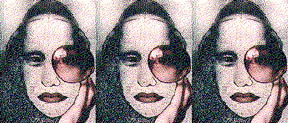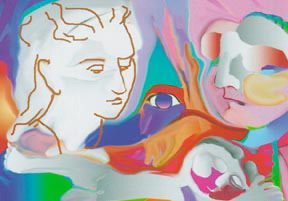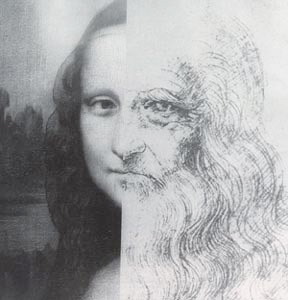Chapter 9: Computer Artists
9.5 Lillian Schwartz


The following text is taken from the artist’s website at http://www.lillian.com
Lillian Schwartz is best known for her pioneering work in the use of computers for what has since become known as computer-generated art and computer-aided art analysis, including graphics, film, video, animation, special effects, Virtual Reality and Multimedia. Her work was recognized for its aesthetic success and was the first in this medium to be acquired by The Museum of Modern Art. Her contributions in starting a new field of endeavor in the arts, art analysis, and the field of virtual reality have been recently awarded Computer-World Smithsonian Awards.
Schwartz began her computer art career as an offshoot of her merger of art and technology, which culminated in the selection of her kinetic sculpture, Proxima Centauri, by The Museum of Modern Art for its epoch-making 1968 Machine Exhibition. She then expanded her work into the computer area, becoming a consultant at the AT&T Bell Laboratories, IBM’s Thomas J. Watson Research Laboratory and at Lucent Technologies Bell Labs Innovations. On her own, and with leading scientists, engineers, physicists, and psychologists, she developed effective techniques for the use of the computer in film and animation.
Besides helping to establish computer art as a viable field of endeavor, Schwartz additionally contributed to scientific research areas such as visual and color perception, and sound. Her own personal efforts have led to the use of the computer in the philosophy of art, whereby data bases containing information as to palettes and structures of paintings, sculptures and graphics by artists such as Picasso and Matisse are used by Schwartz to analyze the choices of those artists and to investigate the creative process itself.
Her contributions to electronic art analysis, and restoration, have been recognized, specifically in Italian Renaissance painting and frescoe. Her work with colleagues to construct 3-dimensional models of the Refectory at Santa Maria Grazie to study the perspective construction of Leonardo’s Last Supper and, more recently, a finite element model of the Leaning Tower of Pisa to aid in the preservation of the tower in understanding its structure, have proved invaluable to Art Historians and Restorers.
Schwartz’s education began immediately after World War II when she studied Chinese brushwork with Tshiro in Japan. Over the following years she studied the fine arts with professionals such as Giannini, Kearns, and Joe Jones. She is self-taught with regard to film and computer interfacing, and programming.
Schwartz has always had close ties to the academic community, having been a visiting member of the Computer Science Department at the University of Maryland; an adjunct professor at the Kean College, Fine Arts Department; an adjunct professor at The Rutger’s University Visual Arts Department; an adjunct professor at the Psychology Department, School of Arts and Sciences, New York University; and is currently a member of the International Guidance Panel, under the co-sponsorship for The Society for Excellence Through Education, Israel, Teachers College, Columbia University and S.A.G.E., and a Member of the Graduate Faculty of The School of Visual Arts, NYC. She has also been an Artist in Residence at Channel 13, WNET.

Schwartz’s work has been much in demand internationally both by museums and festivals. For example, her films have been shown and won awards at the Venice Biennale, Zagreb, Cannes, The National Academy of Television Arts and Sciences, and nominated and received Emmy nominations and award. Her work has been exhibited at and is owned by museums such as The Museum of Modern Art, The Metropolitan Museum of Art, The Whitney Museum of American Art, The Moderna Museet (Stockholm), Centre Beauborg (Paris), Stedlijk Museum of Art (Amsterdam), and the Grand Palais Museum (Paris).
Representing the United States, Schwartz has been a guest lecturer in over two dozen countries, ranging from the Royal College of Art in London to the US/China Cultural Relations speaker in the People’s Republic of China. Schwartz has also had numerous other fellowships, and honors conferred upon her, including a Doctor of Humane Letters Honoris Causa from Kean College, New Jersey, and grants from the National Endowment For The Arts and The Corporation For Public Broadcasting. Most recently she has received Computerworld Smithsonian Awards in three categories: For the Application of the Computer as a Medium in the Arts, including Graphics, Film/Video, and Special Effects; pioneering work in the field of Virtual Reality; and for her contributions in special editing techniques in Media and Arts & Entertainment.

She has been the subject of numerous articles, books, and television news and documentary programs. She is a Fellow in The World Academy of Art & Science. She has been appointed as a committee member of the National Research Council Committee on Information Technology and Creativity under the Computer Science and Telecommunications Board of The National Academies from May, 2000 to December, 2001. Schwartz is the author (together with Laurens R. Schwartz) of The Computer Artist’s Handbook, W.W. Norton & Company.
